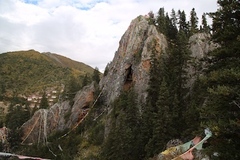Guide to Sengchen Namdrak
Guide to Sengchen Namdrak[1]
by Jamyang Khyentse Chökyi Lodrö
Oṃ svasti!
Magnificent embodiment of the Three Roots,
Mahāguru Vajra Skull Garland (Dorje Tötrengtsal)—
Through the truth of your compassionate blessings,
Quick as lightning, pray confer blessings and fortune.
Having opened with this scattering of the sweet flowers of auspiciousness, let us consider Sengchen Namdrak, place of the activity of enlightened qualities among the twenty-five major sites of Dokham.[2] In the past, the great tertön Düdül Dorje opened this place and wrote an extensive guidebook.[3] Later, Chokgyur Dechen Lingpa revealed an abundance of profound termas here. The anniversaries of the revelation of these profound Chokling treasures take place during the fifth, sixth and seventh months of a mighty monkey year, and also in the first snake month of a snake year. Düdül Dorje explained how beneficial it is to practice approach and accomplishment (bsnyen sgrub), feast offering and fulfilment (tshogs skong), fire offering and so on here during such months and years, as well as how each circumambulation of the place is equivalent to reciting seven hundred million maṇi mantras. In the vajra words of Guru Rinpoche:
Now, as to the benefits of this place:
Prostrations and circumambulations close the doors to rebirth in the lower realms.
Showing reverence brings rebirth in higher states.
Offering gaṇacakra once yields a vast accumulation of merit.
Offering gaṇacakra twice purifies the ripening of karma.
Offering gaṇacakra thrice brings an encounter with me, Padma of Oḍḍiyāna,
In reality or symbolically in dreams or visions.
Offering gaṇacakra a hundred times brings rebirth in a celestial realm.
If you wish for the supreme attainment it is won through single-pointed practice.
Such is this sublime place, so significant to all who encounter it: emaho!
Recalling these words with intense faith and devotion, practise the cultivation of virtue and avoidance of misdeeds in general, and refrain from hunting or the slaughter of wildlife in particular. There is no doubt that exertions in circumambulation, prostration, making offerings and the like during pilgrimage gatherings will pacify illness, harmful influences and obstacles and cause all aspirations to be fulfilled. It is only right, therefore, that those who seek liberation should strive with intense faith and diligence.
Thus, Chökyi Lodrö, who holds the name of a Khyentse incarnation, wrote this in the upper reaches of the Lion Rock valley[4] on the first day of the seventh month of the Wood Sheep year. May it bring virtue and excellence! Maṅgalam.
| Translated by Adam Pearcey with the generous support of the Khyentse Foundation and Tertön Sogyal Trust, 2021.
Bibliography
Tibetan Edition
’jam dbyangs chos kyi blo gros. [Untitled] in ’jam dbyangs chos kyi blo gros kyi gsung ’bum. 12 vols. Bir: Khyentse Labrang, 2012. W1KG12986. Vol. 10: 309–310
Secondary Sources
rgyal mtshan bzang po. mdo khams gnas chen nyer lnga'i gnas yig phyogs bsgrigs. 2 vols. Zi ling: mtsho sngon mi rigs dpe skrun khang, 2013. BDRC W1AC435.
Gardner, Alexander. The Twenty-Five Great Sites of Khams: Religious Geography, Revelation, and Nonsectarianism in Nineteenth-Century Eastern Tibet. Ph.D. thesis. University of Michigan. 2006.
Version: 2.0-20210920
-
The original text is untitled. This title has been added by the translator based on rgyal mtshan bzang po 2013, Vol. 2: 14 ↩
-
The twenty-five places are categorized according to the five of enlightened body, speech, mind, qualities and activity, each of which is then subdivided according to the same five categories. Sengchen Namdrak is the thus the place related to activity among the five places of enlightened qualities. ↩
-
See rgyal mtshan bzang po 2013, Vol. 2: 16–32 ↩
-
Many thanks to Facebook user Naldjor for pointing out an error in the translation, which has been corrected here. ↩
